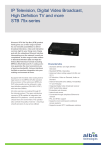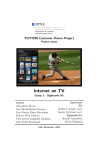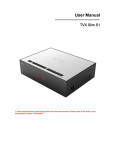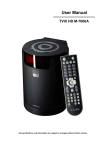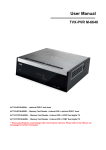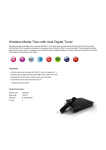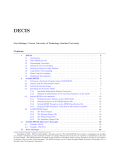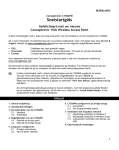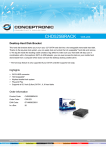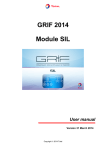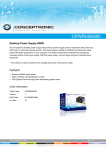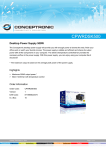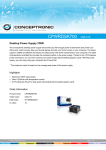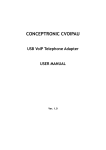Download Conceptronic Media Titan test by MPC club
Transcript
Datum: Maart 2009 Medium: MPC Club Product: Media Titan Conceptronic have produced quite a number of media recorders in the past, a few of which have been reviewed here at MPC. Up for review is their latest and greatest media recorder which now incorporates dual DVB-T tuners and claims to be able to playback Full HD 1080p. Conceptronic have tried to incorporate both a media recorder and a state of the art media player which attempts to go head to head with the like of Dvico, Popcorn Hour for media player capabilities and compatability of playback. We attempt to delve under the cool black slab of its cold exterior and see if it will warm our hearts and become the media recorder/player of choice. We test out the dual tuner capability, playback some SD and HD content, test out its 11n wireless option and have fun setting up a UPnP server. Read on and see what Conceptronic has to offer on this occasion. In The Box: The Media Titan presents itself shrouded in a full colour printed outer carton with all the standards logos that you could ever wish to see, all in prominent positions on the front cover. On the rear is listed the specifications of the device in all of the European country languages that Conceptronic are selling to. Once the outer carton is dispensed with, the inner packaging is all plain cardboard with just the barest minimum of plastic used to protect connecting cables, which is sure to please any Eco friendly recyclers out there. The contents include the following items: • Conceptronic Media Titan Player • Scroll wheel remote control • Remote control batteries • 1.5m Gold Plated HDMI • Gold Plated USB Cable • Composite Cable • Power Supply • Power cord • Multi Language Manual • Warranty Document On the whole the presentation and attention to detail is very slick, right down to the plastic grab handle on top (very handy if you want to reuse the inner carton to carry your sandwiches to work in). My only issue is with the big bold “Full HD1080p” logo on the front cover, which I think is a marketing step too far. However, more on that later….. 2 The Out of the Box Experience Having paid due attention to the marketing blurb on the outer carton, filed the manual in the drawer marked “only to be opened in the event of serious technical dilemma”, you find yourself left with the Media Titan, the remote control and a bunch of familiar looking leads. It’s at this point, when you get your first close look at the unit, that first impressions are formed. In my case, the reaction was… neutral. Let’s be frank, it’s not going to win any beauty contests, but I guess that’s not the point, it’s what’s going on under the hood that counts. Don’t get me wrong, it’s not that it’s an ugly box; it’s just that it’s black, slab shaped and plastic. Still each to their own and when you’re engrossed in action on screen, the last thing you should be thinking about is the shape and colour of the device that’s delivering it. The player however, feels well built and of a high quality. No cheap plastic here, but a well moulded and robustly built unit. So, now onto the flashy lights, cabling and setup part……. The Front Panel: On the front of the unit you will find: - 1x USB Host Port (Very handy for showing Grandma the latest snaps of little Johnny when she comes to visit.) - IR Receiver - Three status LED’s - Reset Button “Wait a minute….. Is that all?” I hear you say. Yes, that’s all there is. There are no fancy organic displays, LCDs or VFDs, which are too small to read from across the room anyway. There’s just a series of three sub miniature LEDs that are either on, off, flashing fast or flashing slow. The Media Titan sequences these to indicate its operational status and a full explanation of what they all mean can be found in the user manual. It may be necessary to retrieve the user manual a little earlier than I first thought. 3 In practice the LEDs are not intrusive or bright enough to cause a major distraction. However, it would be beneficial for the user manual to list the LED colour sequence so that the user can identify if the blue LED is left middle or right. The problem being, the facia is totally blank and if one LED lights, it’s not easy to see from a distance which is illuminated. So, to save the knees and eyesight of anyone purchasing the Media Titan, the LED sequence is as follows: ‐ Green ‐ Blue ‐ Amber To the right of the LED display is the reset button, which is actually just a pin hole. I’m not a big fan of this type of reset but in this case there’s a very good reason for using it. If the reset is held in for 5 seconds, the three LEDs will flash fast and the box will reset. If the reset button is held in for a further 5 seconds (10 in total) the box will reformat its internal drive. That’s not the type of action you want to perform accidentally hence the pin hole reset. The Rear Panel: On the spaghetti side of things, you will find: ‐ Antenna In / Out ‐ Composite video output ‐ Stereo audio output ‐ Digital optical audio output ‐ HDMI output ‐ USB connector (to computer) ‐ Single USB ports (Even through the manual states that a dual port should be present.) DC Input (12v, 4a) The rear panel is clearly marked and logically laid out, though most of the IO ports are clustered to the right of the centre line. This has resulted in a bunching of ports that could cause serious issues with cable ends that have a bulky shroud. For example, the HDMI cable that I used during testing made it almost impossible to plug in a USB computer link cable at the same time and was also perilously close to the audio optical output. Some care may therefore be required in the choice of cables when hooking up the Media Titan in its final position. Also conspicuous by their absence was a component video and S/PDIF outputs, which whilst not absolutely necessary would add a good degree of flexibility to the device. 4 Setup and Play On connection of the PSU, a soft sigh signals that internal 500GB hard disk is spinning up and then all falls silent. There’s not even a hum from the fan, which is very impressive given the small blade diameter, to suggest that anything is working. Then the splash screen appears and confidence is restored. After around 90 seconds the main menu appears, shortly followed by the first time tuner setup. Within 3 minutes, the Media Titan is tuned in and I’m enjoying the benefits of free to air TV or as I like to call it “twenty eight channels of nothing worth watching”. At this point it becomes apparent why the outside of the box is so bland. All the good stuff has been packed on the inside, with the user interface presenting an extremely slick, well thought out and intuitive set of nested menus. Menus are clear, well labelled and operate consistently at each level. This is probably an appropriate time to mention the remote control, which sports a nifty scroll wheel navigation control (not to be confused with the type of scroll wheel you would find on a mouse). The closest analogy that I can think of for this is a jog / shuttle that you will recall from some old VHS players, but this one can also navigate: up, down, left, right and also has a centre select. The description sounds a little cumbersome, but in practice it’s extremely intuitive and proves to be the fastest way to navigate through the menus. It probably also accounts for the reduced number of discrete buttons on the remote, which number only 11. For DVT users, the all important EPG follows in the same vein as all other menus and provides the user with 7 days advance planning for record selection. Whilst the menu system is polished in appearance, its operation did suffer from a lack of feedback. Some menu selections can be a little slow to activate and the user is left wondering whether 5 the button was pressed or not. This can result in the odd bout of furious button pressing due to operator impatience. I would like to see some kind of immediate on screen indication to register the button press so that the user knows when the device is thinking about its next operation. Of course, a little extra processing power or some pruning of the menu code may have alleviated the time lag at key points. Before progressing too far, it was decided to upgrade the device firmware so that any testing was using the latest and greatest that Conceptronic has to offer. An upgrade file was duly downloaded, copied to a RAM drive and plugged into the front USB socket. The Media Titan immediately recognised the firmware file, confirmed that I wanted to perform an upgrade and started the install. The whole process took less than two minutes and before long the device had restarted and was ready to use again. Inserting the RAM drive again caused the device to announce that it already had this version of firmware and no upgrade was necessary. So far so good, though this does suggest that there’s no way back to an earlier version if things don’t quite go according to plan. Following the upgrade to version 1.2.14.7929, any DTV channel with a secondary audio stream selected this as the default when the channel was selected. As most secondary streams are used to deliver commentary for the partially sighted I think that this qualifies as a pretty big bug. The option to roll back to an earlier firmware version is starting to look like a necessity going forward and at the time of writing this review a bug report has been lodged with Conceptronic, whom have stated that their engineers are attempting to reproduce the error so that they may release a bug fix. Fortunately, I had already recorded a couple of test clips so there’s no need to halt proceeding whilst waiting for a response. The even better news is the quality of image for recorded items. Recorded broadcasts are up-scaled, depending upon how you set the resolution capability of your TV, with the resulting playback looking slightly better than the original broadcast. As with all good DTV recorders, the usual party tricks time shifting and pausing live TV are all in evidence and work seamlessly as you might reasonably expect. As for the live TV display, the slick menu theme continues with info menus and option windows sliding onto screen from various quarters. The resulting impression, as with the main menus, is of a very polished product that’s had considerable thought given to the onscreen presentation of information. 6 Away from DTV, the Titan’s internal drive can also be used to store audio, video and still image files, which can be copied across using the USB port at the rear. Alternatively, files can be temporarily accessed by using either of the available USB mass storage ports. I’ve tested both external hard disk access as well as files stored on a pen drive and both operate as expected. The latter of which showed up the second operational bug. For some inexplicable reason, removal of the pen drive and reinsertion created two menu items with the same identification. Removable media menu items appear to be cached and not flushed correctly on removal so another query item is winging its way to Conceptronic. When transferring data from PC to local storage, the USB interface proved to be tediously slow, a fact that Conceptronic are fully aware of and are working to rectify. We should expect a firmware upgrade to address this issue in due course. Menu errors aside, operation of the audio player jukebox is a further triumph of the Media Titans menu display. Tracks are displayed in a standard column list, which can be re-ordered and generally chopped and changed around before being slid into position for playing. The playing track is displayed against a progress slide bar, which really shows off the wheel remote. By rotating the wheel, the track can be skipped forward or reverse as with a jog / shuttle control. In addition the wheel also provides the user with feedback by the use of subtle detents as it rotates. Each detent denotes a speed increment when skipping through. I’m beginning to like this remote a lot! Still image playback has a similar jukebox menu option for the control of transitions and image rotation. However it appears that less thought has been given to this option and I found the operation to be a little clunky in places. Once a slide show had been setup, the image display was crisp with adequate transitions (if somewhat limit in choice). It’s hard to see what else could be added to this element but is somehow felt a little lacking when compared to the other media handling areas. Movie Playback As well as recording, the Media Titan also plays back all the usual video file formats, though you may need to set some time aside if you intend to copy these onto the device using USB! A full list of the supported file formats can be found at the end of this review. Playback is smooth, with no detectable jitter at the higher resolutions. However, it’s at this point that I must say that the outer box claim of “1080p Full HD” playback is, for me, a claim too far. The maximum output resolution for the device is 1080i so, whilst the player will decode 1080p, it must down scale in order to display the image. My test equipment setup is the usual that I use for media player reviews: I utilized the HDMI port into my Pioneer switch which feeds my Pioneer 508D plasma. The audio was fed into my Onkyo 875 receiver via Optical - the method I prefer over using the HDMI input on the receiver for both video and audio. The network was fed via my gigabit LAN connected to a Windows 2003 file server for media content. The main difference with this review is the Titan does not use NFS or SMB for connectivity but utilises UPnP. Conceptronic have however informed us that they are working on incorporating NFS and SMB into a future firmware release, so this should not be a problem and will offer more flexibility to the end user. Playback of 720p MKV content was first up. The movie played fine and I tried streaming it from my fileserver using Twonky UPnP server and from the internal HDD. I could see no lag or stutter at all during the entire section of the movie I watched. This surprised me a little as I expected at least some form of frame drop, especially as Conceptronic had chosen to use the ST-Micro STi7109 chip which is based on the Omega2 architecture. The core CPU is running slower than the Sigma 8635 which is the usual chip of choice for media players. From the information I could dig up on this chipset it appears to be running at 266MHz compared to the 300MHz MIPS used in the Sigma chip. 7 This could be one of the reason the player cannot output Full 1080p HD. I then tried the acid test pushing a 1080p MKV through the player. Although the content was downscaled to 1080i by the player it still played fine and the colours were strong although a little over saturated in places. Contrast was also good, but not the best that I have seen from a media player. content OK, but hell I’m a 1080p snob and a wired connection is a must still unfortunately. During testing a further oddity was also detected when playing a 1080p movie through the composite output to a standard TV. I’m not sure why anyone would want to do this in practice, but I found myself trying this option due to a short term lack of an available display. The resultant playback suffered from serious jitter, to such a degree that it was almost unwatchable. The problem was only evident on 1080p and is probably obscure enough to be not worth worrying about but if you operate in this mode, you have been warned. Network connectivity is either wired or wireless though these cannot be connected at the same time. The Titan only supports UPnP connectivity so you will need a suitable media server on you host system or a NAS with built in UPnP server. If connected to a network at power-on, the Titan will configure its own card for you though if you want to use wireless or feel the need delve into the network configuration, you’ll need to head for the setup icon in the on screen menu. Playback was acceptable at all resolutions though I should add that only wired connectivity was used during the test. The Touch Test: After several hours of goggle box watching - I mean detained and stringent testing - I took the Titan’s temperature and started to wonder if it was actually turned on! Not only is this a super quiet device, it’s also very well cooled. The warmest part was underneath where the internal hard disk is located, even so I think the French polish on your Chippendale sideboard will be quite safe with this sat on the top. Conclusion (Advocate86) With all media players, the user experience has to be the most important element. Most of us forgive some shortcomings with any consumer device provided it meets the main requirements of its primary function. In the case of the Media Titan it makes a very impressive attempt at what it sets out to do and it does it with some considerable style. Okay so it’s not pretty to look at, but that’s more than compensated for by the slick menu navigation and innovative remote control design. In operational terms, the Titan is packed full of features with enough setup options to keep your average tech head happy for several hours. On the other hand if you just want to plug and go, then it ticks that box also. All things considered this is a good player but, it could have been a great player. There are several extremely innovative features and the combination of DTV, internal HDD and multiple media format playback is a seductive proposition. For me however, a little more thought about the appearance and a little more processing power under the hood would have moved this player well and truly towards the chilly end of the “cool wall”. If this is a “must have” for you, aim to pay less than €400. 8









